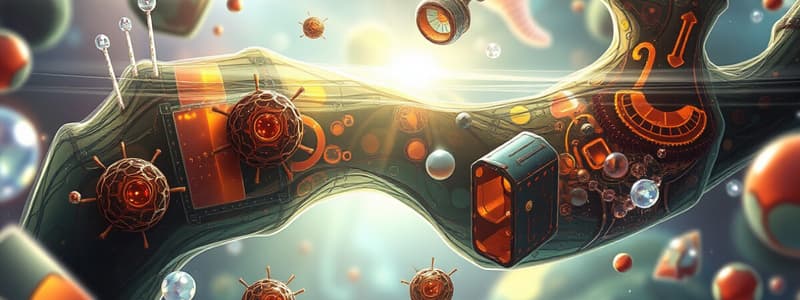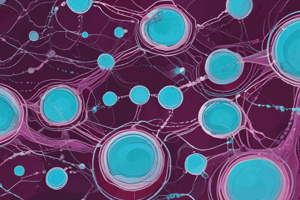Podcast
Questions and Answers
Water moves into a cell placed in a ______ solution.
Water moves into a cell placed in a ______ solution.
hypotonic
Water moves out of a cell if the cell is placed in a ______ solution.
Water moves out of a cell if the cell is placed in a ______ solution.
hypertonic
If cells are placed in a strong sugar solution, water will ______.
If cells are placed in a strong sugar solution, water will ______.
pass from the cells to the sugar solution
A cell moves particles from a region of lesser concentration to a region of greater ______.
A cell moves particles from a region of lesser concentration to a region of greater ______.
The structure most responsible for maintaining cell homeostasis is the ______.
The structure most responsible for maintaining cell homeostasis is the ______.
The causes of cancer may include which of the following?
The causes of cancer may include which of the following?
A gene is a segment of DNA that controls the production of ______.
A gene is a segment of DNA that controls the production of ______.
Which of the following monitors a cell's progress from phase to phase during ______.
Which of the following monitors a cell's progress from phase to phase during ______.
As a cell grows, its ______ increases more than its ______.
As a cell grows, its ______ increases more than its ______.
Among the following, the term that includes the others is ______.
Among the following, the term that includes the others is ______.
By the end of prophase, each of the following has occurred except ______.
By the end of prophase, each of the following has occurred except ______.
Unlike plant cells, animal cells contain ______.
Unlike plant cells, animal cells contain ______.
The longest phase of a cell cycle is ______.
The longest phase of a cell cycle is ______.
A chromatid is attached to a spindle fiber by the ______.
A chromatid is attached to a spindle fiber by the ______.
Which of the following structures is the most complex?
Which of the following structures is the most complex?
If a cell is placed in salt water, water leaves the cell by ______.
If a cell is placed in salt water, water leaves the cell by ______.
Which of the following is not a form of passive transport?
Which of the following is not a form of passive transport?
If the sides of a cell double in length, its volume increases by ______ times.
If the sides of a cell double in length, its volume increases by ______ times.
The final phase of mitosis. A new double membrane begins to form at the end.
The final phase of mitosis. A new double membrane begins to form at the end.
This second phase of mitosis is where the doubled chromosomes become attached to spindle fibers by their centromeres.
This second phase of mitosis is where the doubled chromosomes become attached to spindle fibers by their centromeres.
The first and longest phase of mitosis; long chromatin coils up into visible chromosomes.
The first and longest phase of mitosis; long chromatin coils up into visible chromosomes.
Where the majority of a cells life is spent in the growth period; cells grow and carry out membranes.
Where the majority of a cells life is spent in the growth period; cells grow and carry out membranes.
The sequence of growth and division of a cell.
The sequence of growth and division of a cell.
When the cells cytoplasm divides; follows telophase.
When the cells cytoplasm divides; follows telophase.
The centromeres split apart and chromatid pairs from each chromosome separate from each 3rd phase of mitosis.
The centromeres split apart and chromatid pairs from each chromosome separate from each 3rd phase of mitosis.
A cells period of nuclear division; follows interphase.
A cells period of nuclear division; follows interphase.
Movement of material through a membrane against a concentration gradient. Uses chemicals.
Movement of material through a membrane against a concentration gradient. Uses chemicals.
The diffusion of water across a selectively permeable membrane.
The diffusion of water across a selectively permeable membrane.
The movement of particles across membranes by diffusion. Uses no energy.
The movement of particles across membranes by diffusion. Uses no energy.
The concentration of dissolved substances in a solution is the same as the concentration substances inside the cell.
The concentration of dissolved substances in a solution is the same as the concentration substances inside the cell.
Study Notes
Cell Transport Mechanisms
- Water enters a cell in a hypotonic solution, where the solute concentration is lower outside than inside.
- Water exits a cell in a hypertonic solution, which has a higher solute concentration outside than inside.
- In a strong sugar solution, water flows from cells into the solution due to osmotic pressure.
- Active transport moves particles from areas of lower concentration to higher concentration, requiring energy.
Cell Structure and Function
- The plasma membrane is crucial for maintaining cell homeostasis, regulating what enters and exits the cell.
- Environmental factors, viruses, and UV radiation can be potential causes of cancer.
- A gene, a segment of DNA, directs the synthesis of proteins essential for cellular function.
Cell Cycle and Division
- A series of enzymes monitor the cell's progress through the cell cycle, ensuring proper division.
- As a cell grows, its volume increases more significantly than its surface area, impacting nutrient absorption and waste elimination.
- The cell cycle encompasses several stages, including interphase, mitosis, and cytokinesis.
- The longest phase in the cell cycle is interphase, where the cell grows and prepares for division.
Mitosis Phases
- Prophase is the first phase of mitosis, where chromatin condenses into visible chromosomes.
- During metaphase, duplicated chromosomes align at the cell's equatorial plane and attach to spindle fibers via centromeres.
- Anaphase features the separation of sister chromatids towards opposite poles, facilitated by the splitting of centromeres.
- Telophase marks the end stage of mitosis, where new nuclear membranes form around separated chromatids.
Other Cellular Processes
- Cytokinesis is the final step of cell division, where the cytoplasm divides, resulting in two daughter cells.
- Passive transport involves the movement of substances across cell membranes without energy (e.g., diffusion and osmosis).
- Osmosis is specifically the diffusion of water across a selectively permeable membrane.
- Isotonic solutions have equal solute concentrations inside and outside the cell, maintaining cell size.
- Centrioles are found in animal cells but not in plant cells, playing a role in cell division.
Key Facts
- If a cell's dimensions double, its volume increases eightfold.
- Endocytosis is not a form of passive transport; it requires energy to engulf particles into the cell.
Studying That Suits You
Use AI to generate personalized quizzes and flashcards to suit your learning preferences.
Description
Test your knowledge with these flashcards covering key concepts from Biology Chapter 8. Focus on solutions and cellular movement principles such as hypotonic and hypertonic solutions. Perfect for review and strengthening understanding of cell biology.




